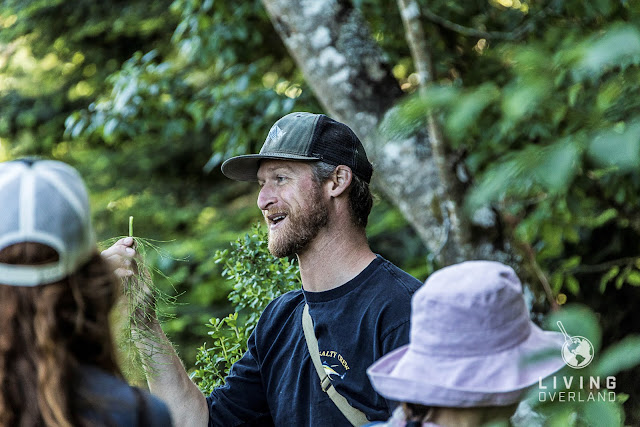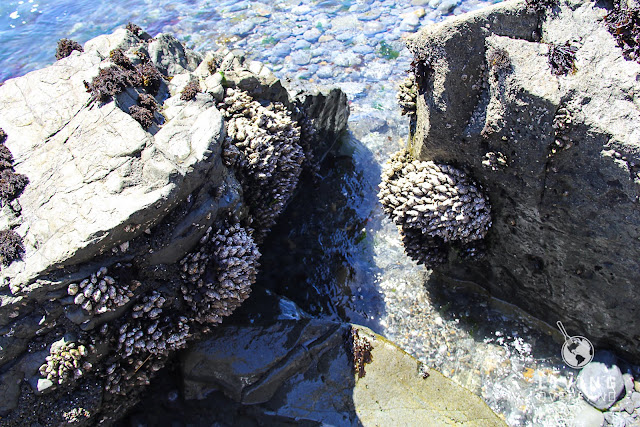Foraging Along California's North Coast
Written by Anthony Sicola
Photos as attributed  |
| Little River Inn: Photo © Anthony Sicola |
You’d be astounded by the amount of food you can find in the wild – or right outside your front door! From wild berries, nuts, plants, and fungi in the woods to shellfish and seaweed fresh out of the ocean. Foraging, or gathering, is an important skill to develop, but even more important is that you learn it from someone who knows what they are doing. There are risks involved in eating certain shellfish, fungi, and plants, like very serious risks…there are things that can sicken or outright kill you if you ingest them, so you need to be careful. But, as Kirk Lombard says in The Sea Forager’s Guide to the Northern California Coast, “…if they (the risks) scare you off, you weren’t committed enough anyway.
As self-sufficient, vehicle-based travelers, we tend to be (over) prepared for everything. We carry recovery kits, extra food and water, first aid supplies, and survival and navigation tools… you know, just in case. Whether or not you ever actually have to use those items, you should be well-versed in HOW to use them if the need should arise. But what happens if you’re separated from your vehicle, or if you need to leave it and hike to secure assistance? Could you find, hunt, or otherwise catch enough food to keep you sustained? We intended to find out!
We had the privilege of attending the inaugural Forage and Ferment Experience at the Little River Inn in Mendocino, CA. Not only is the North Coast of California strikingly gorgeous, with dramatic cliffs dropping into the Pacific Ocean, but it is also an absolute treasure trove of wild edibles. The first nation tribes of the Mendocino Coast used this seasonal bounty to flourish in the area and we were lucky enough to be taught by some expert foragers who study and emulate that native knowledge including, Kevin Smith from Countryman Forager, Erica Fielder from Rising Tide Sea Vegetables, and the folks from the Freedive Shop, who along with Little River Inn Owner Cally Dym, treated us to preparation workshops and cooking demos.
 |
| Kevin Smith. Photo © Brendan McGuigan |
We started the experience with Kevin Smith, who took us on a forest walk where we learned to identify edible wild herbs and plants. In the course of a one-hour stroll through the woods, we identified (and ate) many varieties of berries including, wild Salal berries (Gaultheria shallon), Manzanita berry (Arctostaphylos glauca) which can be made into a cider-like tea, and huckleberry (Vaccinium parvifolium). We found a relative to the chamomile called Pineapple weed, which when crushed, emits a strong pineapple scent. Some people are highly-allergic to chamomile and should never even touch this plant. He introduced us to wild radish, which can be eaten in many ways including eating the fresh seed pods and shaving down the stalk to get to the crispy center – both provide a spicy, radish-like flavor.
 |
| Salal berries. Photo © Anthony Sicola |
Not everything was edible though, Kevin taught us to identify poison oak (which grows as a small shrub near the ocean and grows as a large vine in the forest) he also spent a good amount of time showing us the difference between Poison hemlock and wild fennel – which look remarkably similar, except that one will kill you and the other is nice on a salad. Before you go out on your own, please be 100% sure what you’re harvesting.
 |
| Erica Fielder. Photo © Anthony Sicola |
Next, we caught up with Erica Fielder of Rising Tide Sea Vegetables at Van Damme State Beach (no relation to Jean Claude…I asked) who gave us a quick rundown of the various sea vegetables we could easily pull out of the water including, nori, kombu, wakame, and sea lettuce. The cold, clean, nutrient-dense waters around Mendocino are perfect for responsible sea vegetable harvesting, which simply means that when we harvest these varieties, we leave enough of the holdfast, so the vegetation can regenerate – and we can continue enjoying them into the future.
We put our fishing licenses to use by harvesting fresh nori and sea lettuce from the tide pools and doing some on the fly taste tests. Sea lettuce looks a lot like any other lettuce you might find at the store, it is leafy, bright to dark green, and surprisingly, it a fresh, slightly bitter chlorophyll taste – as any lettuce does. It is better to eat it fresh as drying it causes more of the bitterness to come forward. Sea vegetables can provide many essential nutrients and vitamins, and they just taste good too!
 |
| Erica Fielder Harvesting Sea Vegetables © Brendan McGuigan |
 |
| Paulina Dao Harvesting Sea Vegetables © Anthony Sicola |
After that, we spent some more time in the tide pools identifying edible shellfish like limpets and gooseneck barnacles, clams, mussels, and, more. If you are harvesting bivalves, pay particular attention to the month of the year because these sea animals filter water through them to eat and take in biotoxins, particularly during Red tides. Avoid harvesting in these times!
 |
| Gooseneck Barnacles © Anthony Sicola |
 |
| Limpet © Brendan McGuigan |
That evening we were treated to cooking demonstrations by the staff of the Freedive Shop starting with disassembling and harvesting the roe (uni) from a red urchin, how to open and eat a wild scallop, along with tasty appetizers from the sea from their resident cook, Jason DeMers.
 |
| Red uni. Photo © Brendan McGuigan |
 |
| Sea vegetable ramen © Brendan McGuigan |
We ended the evening with foraged cocktails and a multi-course foraged and wild-caught extravaganza from the Culinary Institute of America trained head chef of the Little River Inn, Marc Dym. It was a wonderful end to a delicious and eye-opening weekend.
 |
| Wild boar ragout by Marc Dym © Brendan McGuigan |
 |
| Salmon rillette by Marc Dym. Photo © Brendan McGuigan |
The staff and owners of The Little River Inn made us feel so welcome and provided the perfect environment for learning, enjoying amazing food, and meeting new people. If you’ve ever thought about learning how to forage we’d highly recommend doing so here, they will have many seasonal foraging sessions in the future including something I want to learn more about, fungi!
While getting there is a bit of a hike, the Little River Inn is secluded and out-of-the-way enough to feel like you’ve completely disconnected from that little screen you carry around in your pocket. With enormous rooms overlooking the ocean, it is a perfect getaway. Don’t miss it if you’re ever traveling the North Coast!
*** Although The Little River Inn allowed us to attend the event free of charge, the content and opinions expressed here are my own. ***
___________________________
Author
 Anthony Sicola is a free-range human, vehicle-based adventurer, IRONMAN, amateur photographer, food-lover, Toyota Land Cruiser fanatic, servant to a Jack Russell Terrier named Digby, and an all-around good friend to have. He’s currently the Sales & Communications Director for Overland Expo, working closely with the most well-known brands around the globe in the overland/ touring industry. You can follow his exploits on Instagram – as long as you’re not adverse to food and dog pics.
Anthony Sicola is a free-range human, vehicle-based adventurer, IRONMAN, amateur photographer, food-lover, Toyota Land Cruiser fanatic, servant to a Jack Russell Terrier named Digby, and an all-around good friend to have. He’s currently the Sales & Communications Director for Overland Expo, working closely with the most well-known brands around the globe in the overland/ touring industry. You can follow his exploits on Instagram – as long as you’re not adverse to food and dog pics.
___________________________
If you found this article helpful, please consider using one of the affiliate links below. The price is the same for you, but a small percentage of the purchase price goes to us, which helps keep this site going. Thank you!